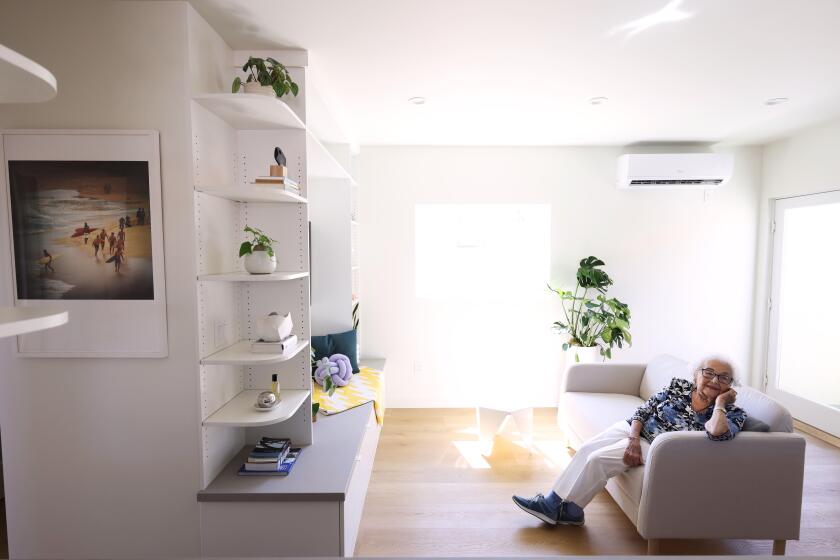Wealth of Historic Architecture Is Hidden in Old Altadena
The old Gillette hunting lodge overlooking Rubio Canyon in Altadena will be the appropriate setting today for a garden party to raise funds for a survey of historic houses in the community.
Said to have been built in 1890, the rambling, weathered lodge--all but hidden deep on a one-acre lot at 1391 E. Palm St. up an ivy-encrusted, tree-shaded lane--is one of the community’s older surviving structures.
The party, featuring a photo display of old Altadena, an art exhibit and musical performances, will run from 1 to 4 p.m. Entrance is $6, with proceeds going to the heritage committee of the Altadena Town Council, which is sponsoring the historic survey.
The survey is very much needed, for unincorporated Altadena, lying north of Pasadena, is an architecturally rich community that has been ignored in most guidebooks because it’s somewhat out of the way. Touring there recently after checking out the Gillette property revealed a number of delights.
For a sense of the diversity of the houses in Altadena, diagonally across the street from the Gillette lodge is a proud, pink-toned stucco Spanish colonial revival-styled structure, replete with Churrigueresque terra-cotta ornamentation. Its address is 1366 E. Palm St.
Before being developed for such extravagances in the 1910s and ‘20s, many of which still grace the community, Altadena was a rural expanse of citrus groves, chicken farms and ranches. Check out the boulder gateposts at the northeast corner of Palm Street and Holliston Avenue, which is said to have served as an entrance to a ranch there at the turn of the century.
Boulders that had been washed down the mountain and were found in dry river beds were used in a lot of the construction and landscaping of Altadena. For an engaging illustration, take a drive down Boulder Road (a block or so east of Holliston Avenue), from Altadena Drive to Braeburn Road.
There are many such “theme” streets in the community. Another, just south of Boulder and off Holliston, is La Solana Drive, which is lined with modest Spanish colonial revival-styled houses, creating a distinctive sense of place and time.
Further south, at the northeast corner of Mar Vista Avenue and Sonoma Drive, is a Spanish revival-styled house noteworthy for the fact it was designed by the brothers Charles and Henry Greene, who are best known for their exquisite bungalows. The house is dated 1915 and marked by a green tile roof and an ornamented front entry.
There are a few Greene and Greene bungalows in Altadena, including one at the northwest corner of Santa Anita Avenue and East Calaveras Street, and another at the southeast corner of Mariposa Street and Maiden Lane. The one on Santa Anita is hard to see from the street because of shrubs and the one on Mariposa is quite modest, though the trees that shade the corner are quite marvelous.
Frankly, better examples of the bungalow style can be seen at 1337 E. Boston Street and at 1605 E. Altadena Drive, at the northwest corner of Porter Avenue. The latter was designed in all its rambling, wooded glory by Arthur Heineman in 1909 on a site in Pasadena, only to be overwhelmed there a few years ago by encroaching development and then moved to Altadena. With a foundation of new boulders, the structure, known as the Parsons Bungalow for its original owner, seems very much at home.
There also are some “modern” homes in Altadena. Out of the 1930s and in the international style are 1981 Meadowbrook Drive, off Allen Avenue, designed by Richard Neutra; and 596 E. Punahou St., by Harwell Harris. Also worth a view behind its front hedges at 1370 Morado Place is a house designed by Frank Lloyd Wright in 1949, and at 2275 N. Santa Rosa Ave. a so-called case-study house designed in 1958 by the firm of Buff, Straub and Hensman.
But more interesting are Altadena’s older houses, in particular two west of Lake Avenue at 654 and 396 Mariposa Ave. At 654 is a Victorian fantasy designed by Frederick Roehrig in 1888 for A. N. McNally (of Rand-McNally map fame). Obviously altered several times over the last nearly 100 years, the tower-topped house still exudes an engaging pride.
Aging less well is the Mediterranean-styled mansion at 396, which was designed by Myron Hunt in 1907 for author Zane Grey. Yet, looking through the frail hedges and down the curving driveway, one can sense in the fading two-story structure a hint of Altadena’s past and, if local preservationists prevail, its future.
*
--- UNPUBLISHED NOTE ---
The house at 1370 Morado Place mentioned in this story was not designed by Frank Lloyd Wright as it says, but by his son, Lloyd Wright.
--- END NOTE ---
More to Read
Sign up for Essential California
The most important California stories and recommendations in your inbox every morning.
You may occasionally receive promotional content from the Los Angeles Times.






